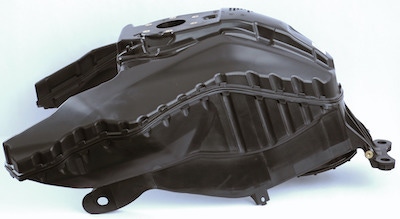Double-shell, welded BMW motorcycle tank delivers high gasoline barrier.
April 6, 2020

Materials for motorcycle tanks need to meet stringent requirements. This means, for example, that only very small amounts of fuel should be able to diffuse through the tank walls. Further, the materials need to demonstrate a high level of tenacity and ductility, particularly in the event of a crash, offer high design flexibility for complex tank geometries, and should be cost-effective to process.
|
Unreinforced and impact-modified PA 6 used in BMW motorcycle fuel tank meets permeation requirements of U.S. EPA. Photo: BMW Motorrad |
BMW Motorrad’s models F 900 R and F 900 XR have been able to meet all of these requirements thanks to a single material. The tanks in both machines are made from Durethan BC550Z 900116 DUSXBL polyamide 6 (PA 6) from Lanxess. The unreinforced and impact-modified PA 6 is injection-molded into two half-shells, which are then welded to form a tank by means of hot plate welding.
“Our material comfortably meets the stringent requirements of the United States Environmental Protection Agency (EPA) with regard to permeation. Since it is very easy to process using injection molding, even complex geometries can be produced cost-efficiently. And when it comes to impact loading, this extremely tough material really shows its strengths,” explains Klaus Küsters, Business Development Manager Blow Molding in the High Performance Materials (HPM) business unit of Lanxess. The tanks are a joint development of BMW Motorrad and Röchling Automotive Italia S.r.l. in collaboration with Lanxess.
If the wall thickness is designed accordingly, the permeation values of the monolayer solution are several times lower than the limit of 1.5 grams per square meter of inner surface per day (g/m2d) as required by the U.S. EPA (Environmental Protection Agency) in EPA 40 CFR.
The monolayer solution with PA 6 has several advantages over previously used tank materials. The design flexibility and the integration potential of this material are significantly higher in comparison to metals, such as sheet steel and aluminum. There is also no need for costly forming, stamping, and joining steps. Corrosion is also not a factor when polymers are used. Durethan BC550Z 900116 DUSXBL has significantly lower fuel permeation compared to other polymers, such as high density polyethylene (HDPE). Although fluorination can further reduce permeation in HDPE tanks, it is advantageous to avoid this additional manufacturing step due to the costs involved and the chemically aggressive fluorine.
The monolayer solution with PA 6 is significantly less expensive than multi-layer systems that contain a highly polar layer, usually made of ethylene vinyl alcohol copolymers, as a permeation barrier.
Durethan BC550Z 900116 DUSXBL was originally developed for the blow molding process and has proved its worth in the series production of fuel tanks over the course of several years now. Due to the increasing number of functions in motorcycles – for example, ASC (automatic stability control) – the installation space for fuel tanks is becoming increasingly fragmented and complex. These geometries are no longer suitable for the blow molding process. For this reason, for the current BMW Motorrad tanks, two halves are injection-molded and then welded to form the tank.
“With the injection molding process, it is not only possible to produce more complex geometries, the wall thickness distribution can also be precisely controlled, which in turn facilitates a more precise tank design using CAE tools,” explains Küsters. The welding properties of polyamide 6 are essential for reliable tank production. “This material is characterized by its excellent welding abilities. Our customers have a wide process window at their disposal to reproducibly create tight weld seams. A weld seam factor of 1 can be achieved easily,” says Frank Krause, expert in plastic welding at Lanxess.
Another special feature of this material solution is its very high impact resistance. This means that the fuel bladder remains intact and no fuel escapes even in the event of a crash. Pendulum impact tests on aged tanks, for example, do not result in leaks at -20°C or at 60°C. Due to its property profile, Durethan BC550Z 900116 DUSXBL is also suitable for tanks for small vehicles, such as quad bikes, snowmobiles, and ride-on mowers, and for gasoline-powered garden tools, such as chainsaws and leaf blowers.
About the Author(s)
You May Also Like





